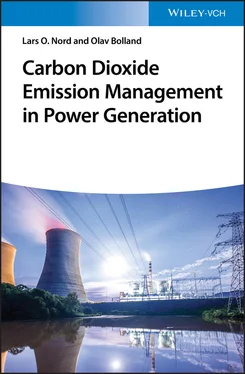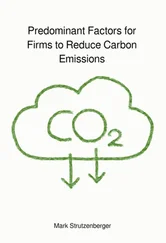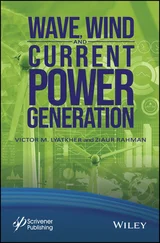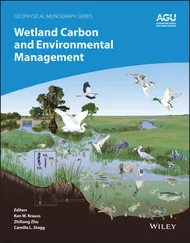4 Reduce deforestation and thereby biologically fixate more CO2 in biomass.
One could also include negative emission technologies by combining (1) and (3) to use bioenergy with CCS and possibly direct air capture (Bui et al. 2018).
Reducing the need for energy is a very difficult topic. The use of energy is very much related to the economic activity level and very important to things humans perceive as affecting their quality of life: the comfort of climatised homes, appliances, freedom to travel by car and to fly to faraway destinations by airplane, communication, and a rich supply of food and drink. These are highly esteemed values in the life of an increasing number of people around the world. Despite growing environmental consciousness among people, it is likely that these values will be very much contended.
Why capture CO 2 ? In the various processes where CO 2is generated, it ends up diluted with a number of other gases. In power plants, the CO 2concentration in the flue gas may be around 12–15 vol% for coal and 3–8 vol% for natural gas. In industrial processes, cement production gives a concentration of about 20 vol% of CO 2and refineries 3–8 vol%. Most of the gas streams containing CO 2are at or close to atmospheric pressure, which means that CO 2is present at a rather low partial pressure 5 . It is commonly accepted that it requires too much energy to store the CO 2with all its diluents away from the atmosphere. This means that CO 2needs to be separated – or captured – from other gases and be brought up to a sufficient pressure for storage. The separation process involves mass transfer, which requires a certain volume and residence time, as well as energy use.
Where should the CO 2 be captured? In general, large point sources, preferably with a high CO 2concentration, are the most economical. About 40% (42% in 2016) of the energy-related CO 2emissions originate from the heat and power generation sector, which represents the largest CO 2emitter followed by transport and industry (International Energy Agency 2018). Power generation is also important because it is the sector that has by far the highest number of the very large CO 2emission point sources. Another area, which is of interest with respect to CO 2capture, is that of plants producing synthetic fuels or chemicals from coal gasification. One should expect that the demand for transportation fuels will be larger than that which can be provided by conventional oil production and that unconventional oil resources have to be used. Gasification of coal, biomass, pet coke, and other heavy oils will likely be important in the future. Gasification processes are mostly well suited for CO 2capture.
It is important to keep in mind that CCS is a chain consisting of capture, transport, and storage (Gielen and Podkanski 2004). The chain may be long geographically, with possibly several hundreds of kilometres between capture and storage. The chain would normally have a very limited buffer capacity, meaning that when CO 2is captured, it has to be transported and stored within a short time frame (hours). Because of the large flow rates and volumes of CO 2(refer to Example 2.1), it is not an easy task to have an intermediate storage that can remove the tight link between the capture and the storage. This means that the operation of the components in the chain is closely coupled. A larger number of sources (capture plants) and sinks (storage sites) can, to some extent, make the operation of the chain more flexible, in both the short term (hours) and the long term (years). In addition, one can think of intermediate storage of CO 2in salt domes, as is being done with natural gas. Further, the storage has to be effective in terms of actually keeping the CO 2away from the atmosphere for more than a thousand years.
Can CCS contribute to a significant reduction in greenhouse gas emissions? The International Energy Agency (IEA) projects the increase in world energy demand and the associated increase in CO 2emissions by utilising different scenarios. Two of the scenarios are used in Example 1.1. The New Policies Scenario takes account of the broad policy commitments and plans that have been announced by countries around the world to tackle either environmental or energy-security concerns, even where the measures to implement these commitments have yet to be identified or announced. The 450 Scenario includes actions necessary to have approximately a 50% chance of meeting a 2 °C increase in global average temperature from pre-industrial levels. To meet this goal, predictions indicate a need to limit the atmospheric CO 2concentration to 450 ppmv . To decrease the CO 2emissions from the New Policies Scenario to the 450 Scenario, several measures would be necessary. This includes a focus on energy efficiency, an increase in renewable energy, nuclear energy, and CCS. Seventeen percentage of the decrease in CO 2emissions would be covered by CCS by the year 2035 (IEA 2012). Example 1.1gives an example on the number of CCS plants necessary to achieve this.
Example 1.1 CCS as part of the measures to get from the New Policies Scenario to the 450 Scenario .
CCS under the ‘450 Scenario’
Assumptions :
New Policies Scenario does not include CCS.
17% (2.5 Gt CO 2) of the difference in CO 2emissions from the New Policies Scenario to the 450 Scenario is covered by CCS by 2035 (IEA 2012).
CO 2captured in a CCS plant: 2.5 Mt/yr.
Total number of CCS plants to build before 2035:

Annual CCS plants to build from 2016–2035:

The numbers in Example 1.1point to the challenges for CCS to reach the goal of limiting the CO 2concentration in the atmosphere to 450 ppmv. To build somewhere in the range of 1000 CCS plants before the year 2035 is a big economic, political, and practical challenge, but not unsurmountable.
1.9 Public Acceptance of CCS
Is CO 2 capture and storage a technology we will accept? If we develop CCS on a large scale, it will have an impact on society in general and on the way we live. Significant resources have to be invested to cover for operating expenses, which could be used in alternative ways in society. A very real concern – in particular, for onshore CO 2storage – is whether the public will allow storage activities ‘in their own backyard’.
Concerns and scepticism over CCS can be exemplified by the following questions and statements:
1 What is the point of CCS in a few rich countries, while other booming economies are increasing their emissions more than the reductions realistically achieved by CCS?
2 CCS will greatly increase the cost of power and of industrial production, so much of the industrial production will move to other countries with less stringent caps on CO2 emissions and with even more greenhouse gas emissions as a consequence!
3 Climate change is already happening, and we are too late and not able to perform enough CCS to avoid a major change in the climate.
4 Will the CO2 stored in the ground remain there or will it leak out into the atmosphere after a few years?
5 The CO2 could leak out of the ground and kill people!
6 Who is responsible in the long term for CO2 stored in the ground?
Читать дальше














